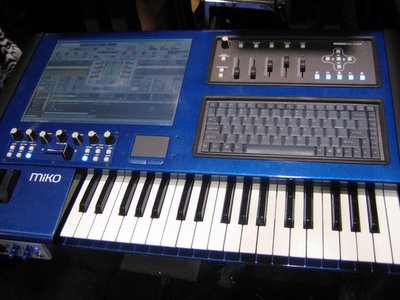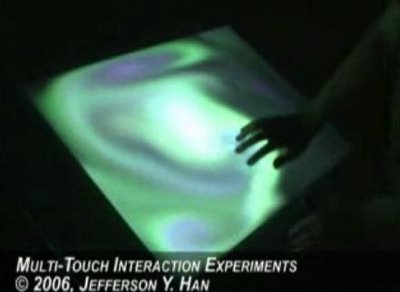

Monday, February 13, 2006
G2 Audio Controlling a Korg MS10
Merleon Cedraeon - Elecktroplankton Compositions

Title link takes you to Merleon Cedraeon with a set of compositions made with Elecktroplankton. Enjoy.
The Meyermoog
Now this is something I bet a lot of us think of doing. Jason and Bob Meyer took a Creamware ASB Minimax, an M-Audio Keystation 49e, some wood, and built their own poly Minimoog, complete with a hinged control panel. I've always wanted to do this with a stack of Waldorf Pulses. Pretty cool. Title link takes you to more shots. The details of the project from Jason are below. Thanks Jason!

"i just thought i'd share with you the fake moog that i built. it's built from the new-ish creamware minimax asb and an m-audio keystation 49e. the keystation was gutted and the lower five keys were removed. both the keystation and the minimax can use the same ac adaptor, so i hard-wired them both to the same ac adaptor which is wired to a PC style power plug port. the ac adaptor and all the power wiring is hidden in one of the small compartments that are connected to the sides of the minimax to make it the correct width for the keyboard. now it uses a standard PC style power cable instead of the cruddy wall-wart. i soldered a midi cable directly to the internals of both units, to not have to bother with a midi-cable. my dad cut all the wood for the case for me (out of oak), from plans i drew up using the original dimensions of the minimoog. i assembled and stained it a dark walnut color. the top panel is hinged just like the original. i'm still working on a left-hand controller with wheels, so there is a temporary controller in it's place with knobs for pitch and modulation. though i definitely plan on replacing them with wheels, having knobs instead is kind of growing on me. the minimax asb was $800, the keystation was something i already had, but can be bought new for $100. the wood and other supplies were about $100, and it took about two weeks of a couple hours every night to build it. so about $1,000 for a polyphonic minimoog that won't ever need adjusting and that i don't have to be afraid to take out of the house.
thanks for a cool blog, i hope you find this interesting!
-jason meyer"
Definitely interesting! Thanks Jason.

"i just thought i'd share with you the fake moog that i built. it's built from the new-ish creamware minimax asb and an m-audio keystation 49e. the keystation was gutted and the lower five keys were removed. both the keystation and the minimax can use the same ac adaptor, so i hard-wired them both to the same ac adaptor which is wired to a PC style power plug port. the ac adaptor and all the power wiring is hidden in one of the small compartments that are connected to the sides of the minimax to make it the correct width for the keyboard. now it uses a standard PC style power cable instead of the cruddy wall-wart. i soldered a midi cable directly to the internals of both units, to not have to bother with a midi-cable. my dad cut all the wood for the case for me (out of oak), from plans i drew up using the original dimensions of the minimoog. i assembled and stained it a dark walnut color. the top panel is hinged just like the original. i'm still working on a left-hand controller with wheels, so there is a temporary controller in it's place with knobs for pitch and modulation. though i definitely plan on replacing them with wheels, having knobs instead is kind of growing on me. the minimax asb was $800, the keystation was something i already had, but can be bought new for $100. the wood and other supplies were about $100, and it took about two weeks of a couple hours every night to build it. so about $1,000 for a polyphonic minimoog that won't ever need adjusting and that i don't have to be afraid to take out of the house.
thanks for a cool blog, i hope you find this interesting!
-jason meyer"
Definitely interesting! Thanks Jason.
The BRONTOLOGIC
Another interesting piece. Details below by Stephen of parsick.com. Title link takes you to Codex flores, what appears to be the home of the BRONTOLOGIC. Thanks Stephen!
Unfortunately I couldn't find a bigger shot. Update: bigger pic below.
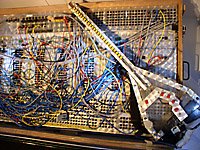
"The Brontologic was designed by a certain Werner Lambertz who had originally made a fortune selling jeans trousers (of all things...) in Germany in the 1970s. The first instrument was presented around 1979/1980. Lambertz´ idea was to design a musical computer that automatically produced good music, without any faults that musicians would create. Later, Kurt "Pyrolator" Dahlke of Germany´s proto electro band Der Plan (The Plan) wanted another machine like that as he felt this was something he could push the limits with, thus he started building a second Brontologic, assisted by Lambertz, in around 1980/81.
Basically, it was a sequencer which had several counters running in parallel, synced to a master clock. It was capable of producing up to six (I think) sequences at the same time, all running at different rates, having different numbers of steps, and all could be set up to different cycling modes independent from each other. I never quite figured how pitches were determined as it had no pots for adjusting voltages, just half a million of banana patch sockets. I guess each patch point in a horizontal row represented one pitch while the sequencer progressed vertically from the top to the bottom (though I have no evidence for that). It allowed the user to interact with the sequencer patterns, have one play backwards, have another stop at a certain point, or have yet another one shift its start and end points continously during playback. When fully patched up, it looked like "Spaghetti Bolognese" as Dahlke once pointed out. As an external controller the operator used some thing called "DIGitarre", made of stainless steel tubing and shaped vaguely guitar-like with loads of switches which allowed control over certain parameters of the Brontologic. Dahlke later admitted it was sort of bizarre to use this controller which clearly resembled the traditional rock´n´roll-type guitar while they were trying to get away from these overused r´n´r clichés.
In a 1993 interview with Germany´s KEYBOARDS magazine, Dahlke briefly explains the Brontologic. He used it to control his Korg MS-20 and later, he had an Emulator One interface built into it. Functionally, Dahlke compared the Brontologic with Buchla´s Thunder which allowed for similarly complex interactions with parameters and sequences on a MIDI level. I´m sorry I don´t have this issue available right now, maybe some fellow AHer could look it up for me (May 1993 issue, I think).
In my view, this device was sort of a comedy of errors. It must have been immensely expensive, and it was huge (about 2.5 metres square). It had an intimidating user interface, and it took ages to patch up. I think something along these lines could have been made in a simpler manner (like having a Serge Touch Keyboard Sequencer) but at that time Serges weren´t hugely popular in Germany. Neither were Buchlas. It seems to me that the Brontologic was best-suited for fractal-like sequencer patterns.
There is a nice track (180°) by Der Pyrolator on a compilation called "Verschwende Deine Jugend" (waste your youth) which sounds very much like a blueprint for the Node track "Alternator", all done on Korg MS-20 and Emulator One, most probably controlled by the Brontologic.
Sorry not to have more info,
Stephen."
 Update via marcel: "on http://gesellschaftsinseln.de/
Update via marcel: "on http://gesellschaftsinseln.de/punkbuch/fotos_78.html you'll find one bigger pic of the bronto, and much more old punk pixs
site is made from the author of "verschwende deine jugend", a book about punk and new wave in germany, juergen teibel"
Update via pyrolator in the comments:
"I found this article, not all of it is correct, but nevertheless thank you for talking about it. The Brontologik2 is now standing in a museum and I decided to write it in Max/Msp with a few further modifications, which was called the bronotlogik3. About two years ago I saw the monome and the potential to be the perfect controller for the brontologik4, which is written for the monome256.
More informations:
http://brontologik.blogspot.com/
http://docs.monome.org/doku.php?id=app:brontologik4
best wishes
pyrolator "
some vids:
a composing system
6 layer sending midi data (pitch, velocity and 2 controller)
1 layer starting clips in ableton live
8 variations each layer
8 modes (for each layer) to manipulate and arrange pitch, velocity, controller, scales, transpose, key, pattern length, randomness and probability of playing.
load and save single pattern or complete data
This is the first public-beta now.
This is Donationware and will be availible at:
brontologik.blogspot.com/"
Unfortunately I couldn't find a bigger shot. Update: bigger pic below.

"The Brontologic was designed by a certain Werner Lambertz who had originally made a fortune selling jeans trousers (of all things...) in Germany in the 1970s. The first instrument was presented around 1979/1980. Lambertz´ idea was to design a musical computer that automatically produced good music, without any faults that musicians would create. Later, Kurt "Pyrolator" Dahlke of Germany´s proto electro band Der Plan (The Plan) wanted another machine like that as he felt this was something he could push the limits with, thus he started building a second Brontologic, assisted by Lambertz, in around 1980/81.
Basically, it was a sequencer which had several counters running in parallel, synced to a master clock. It was capable of producing up to six (I think) sequences at the same time, all running at different rates, having different numbers of steps, and all could be set up to different cycling modes independent from each other. I never quite figured how pitches were determined as it had no pots for adjusting voltages, just half a million of banana patch sockets. I guess each patch point in a horizontal row represented one pitch while the sequencer progressed vertically from the top to the bottom (though I have no evidence for that). It allowed the user to interact with the sequencer patterns, have one play backwards, have another stop at a certain point, or have yet another one shift its start and end points continously during playback. When fully patched up, it looked like "Spaghetti Bolognese" as Dahlke once pointed out. As an external controller the operator used some thing called "DIGitarre", made of stainless steel tubing and shaped vaguely guitar-like with loads of switches which allowed control over certain parameters of the Brontologic. Dahlke later admitted it was sort of bizarre to use this controller which clearly resembled the traditional rock´n´roll-type guitar while they were trying to get away from these overused r´n´r clichés.
In a 1993 interview with Germany´s KEYBOARDS magazine, Dahlke briefly explains the Brontologic. He used it to control his Korg MS-20 and later, he had an Emulator One interface built into it. Functionally, Dahlke compared the Brontologic with Buchla´s Thunder which allowed for similarly complex interactions with parameters and sequences on a MIDI level. I´m sorry I don´t have this issue available right now, maybe some fellow AHer could look it up for me (May 1993 issue, I think).
In my view, this device was sort of a comedy of errors. It must have been immensely expensive, and it was huge (about 2.5 metres square). It had an intimidating user interface, and it took ages to patch up. I think something along these lines could have been made in a simpler manner (like having a Serge Touch Keyboard Sequencer) but at that time Serges weren´t hugely popular in Germany. Neither were Buchlas. It seems to me that the Brontologic was best-suited for fractal-like sequencer patterns.
There is a nice track (180°) by Der Pyrolator on a compilation called "Verschwende Deine Jugend" (waste your youth) which sounds very much like a blueprint for the Node track "Alternator", all done on Korg MS-20 and Emulator One, most probably controlled by the Brontologic.
Sorry not to have more info,
Stephen."
 Update via marcel: "on http://gesellschaftsinseln.de/
Update via marcel: "on http://gesellschaftsinseln.de/site is made from the author of "verschwende deine jugend", a book about punk and new wave in germany, juergen teibel"
Update via pyrolator in the comments:
"I found this article, not all of it is correct, but nevertheless thank you for talking about it. The Brontologik2 is now standing in a museum and I decided to write it in Max/Msp with a few further modifications, which was called the bronotlogik3. About two years ago I saw the monome and the potential to be the perfect controller for the brontologik4, which is written for the monome256.
More informations:
http://brontologik.blogspot.com/
http://docs.monome.org/doku.php?id=app:brontologik4
best wishes
pyrolator "
some vids:
brontologik4 for monome 256 (quick walkthrough) from pyrolator on Vimeo.
"brontologik4 for monome 256a composing system
6 layer sending midi data (pitch, velocity and 2 controller)
1 layer starting clips in ableton live
8 variations each layer
8 modes (for each layer) to manipulate and arrange pitch, velocity, controller, scales, transpose, key, pattern length, randomness and probability of playing.
load and save single pattern or complete data
This is the first public-beta now.
This is Donationware and will be availible at:
brontologik.blogspot.com/"
The SALMAR CONSTRUCTION
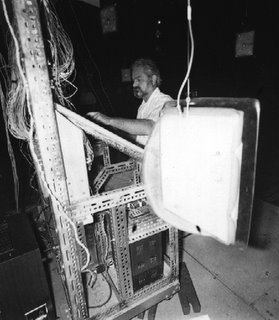
Interesting piece. Title link takes you to more. "In 1969, Salvatore Martirano along with a group of engineers and musicians at the University of Illinois began work on the design and construction of a musical electronic instrument. The instrument, named the SAL-MAR CONSTRUCTION, is a hybrid system in which TTL logical curcuits (small and medium scale integration) drive analog modules, such as voltage-controlled oscillators, amplifiers and filters.
The performer sits at a horizontal control panel of 291 lightable touch-sensitive switches (no moving parts). The two-state switches are used by a performer to dial sequences of numbers that are characterized by a variety of intervals and lengths. A sequence may then bypass, address, or be added to other sequences forming an interlocked tree of control and data according to a performer's choice. The unique characteristic of the switch is that it can be driven both manually and logically, which allows human/machine interaction. The most innovative feature of the human/machine interface is that it allows the user to switch from control of macro to micro parameters of the information output. This is analogous to a zoom lens on a camera."
Digital Performer 5
Title link takes you to a pdf of the full press release with more detail.
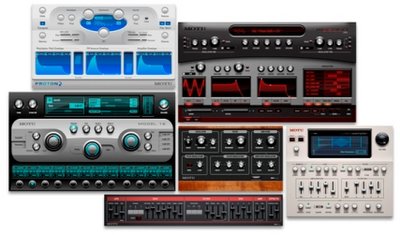
Six New Instrument Plug-ins:
BassLine™ is a one oscillator, two-waveform monophonic bass synth that lets users quickly dial up that perfect analog bass sound. With a streamlined design consisting of two waveforms (saw and square), one low-pass filter with cutoff and resonance, simple decay envelopes for the filter and amplifier and several additional classic analog synth features, BassLine is an easy and enjoyable instrument that delivers great analog bass sounds with just a few turns of its dials.
PolySynth™ is a polyphonic synth with a distinct look that harkens back to the classic Roland Juno 106. PolySynth is capable of a much wider variety of sounds than BassLine, thanks to its digital controlled oscillator (DCO), which can be adjusted with varying amounts of de-tune, triangle wave, sawtooth, rectangle (square) wave, sub-oscillator 1 & 2 and noise. The single LFO can modulate pitch (for vibrato), pulse width (for the square wave and sub-oscillators) or filter depth (for the classic "wah" effect, among others). The resonant low-pass filter is equipped with frequency and resonance controls, key tracking, velocity control and an ADSR envelope, which can also be applied as an overall envelope for each note. Chorus and distortion provide plenty of punch for the thickest of pads and searing lead lines.
Modulo™ significantly raises the subtractive synthesis stakes by providing two oscillators plus noise, 58 available digital waveforms for each oscillator (including sine, square, saw, rectangle, etc.), oscillator phase and symmetry modulation, two LFOs, a resonant multimode filter, three envelopes (for the amplifier, filter and general purpose modulation) and a 5x7 modulation matrix, which supplies five sources applied to up to seven possible destinations. With built-in bank and patch management features and dozens of clearly organized presets, Modulo provides users with accessible yet limitless possibilities for analog synth sounds.
Nanosampler™ allows users to drag and drop any sample (up to five seconds long) from anywhere in DP (or from the Mac OS X Finder) into its graphic sample display and then set a start time, end time, loop (if desired) and crossfade. A multimode filter, amplifier envelope, filter envelope and LFO provide all of the essential features needed for basic sampler programming. True to its name, Nanosynth is highly CPU-efficient and the user can open as many instances of it as they need during a project to play back an infinite variety of sampler sounds.
Model 12™ is a twelve-part drum module. Hundreds of supplied drum sounds and dozens of drum kits can be quickly loaded into its twelve drum parts, which can be individually programmed with controls for pitch (formant corrected or conventional pitch shifting), time stretch, duration (decay or gate), volume & pan, two sends, and a resonant multimode filter with drive. Modulation of many of these controls is available by dragging controls in the virtual LCD display at the top of the window. Drum tracks are now easier to program than ever before.
Proton™ is the sixth and final instrument plug-in included with DP5. Proton is a two-operator frequency modulation (FM) synthesizer that delivers classic, bright, shimmering and expressive FM synth sounds that serve as a perfect compliment to the rest of DP5's new instrument lineup. The pioneering Yamaha DX7 delivered a wide range of sounds using only sine waves with six operators. Proton delivers an equally broad palette of sounds with a streamlined 2-op architecture driven by a simple wavetable knob, instead of the added overhead and complexity of additional operators. As such, Proton may be the most easily programmable FM synth ever created. A real-time display in the center of the window shows the user the spectral content or periodic waveform being generated by the current settings. Additional controls include an FM LFO, modulation pitch envelope, FM amount envelope and overall ADSR envelope.

Six New Instrument Plug-ins:
BassLine™ is a one oscillator, two-waveform monophonic bass synth that lets users quickly dial up that perfect analog bass sound. With a streamlined design consisting of two waveforms (saw and square), one low-pass filter with cutoff and resonance, simple decay envelopes for the filter and amplifier and several additional classic analog synth features, BassLine is an easy and enjoyable instrument that delivers great analog bass sounds with just a few turns of its dials.
PolySynth™ is a polyphonic synth with a distinct look that harkens back to the classic Roland Juno 106. PolySynth is capable of a much wider variety of sounds than BassLine, thanks to its digital controlled oscillator (DCO), which can be adjusted with varying amounts of de-tune, triangle wave, sawtooth, rectangle (square) wave, sub-oscillator 1 & 2 and noise. The single LFO can modulate pitch (for vibrato), pulse width (for the square wave and sub-oscillators) or filter depth (for the classic "wah" effect, among others). The resonant low-pass filter is equipped with frequency and resonance controls, key tracking, velocity control and an ADSR envelope, which can also be applied as an overall envelope for each note. Chorus and distortion provide plenty of punch for the thickest of pads and searing lead lines.
Modulo™ significantly raises the subtractive synthesis stakes by providing two oscillators plus noise, 58 available digital waveforms for each oscillator (including sine, square, saw, rectangle, etc.), oscillator phase and symmetry modulation, two LFOs, a resonant multimode filter, three envelopes (for the amplifier, filter and general purpose modulation) and a 5x7 modulation matrix, which supplies five sources applied to up to seven possible destinations. With built-in bank and patch management features and dozens of clearly organized presets, Modulo provides users with accessible yet limitless possibilities for analog synth sounds.
Nanosampler™ allows users to drag and drop any sample (up to five seconds long) from anywhere in DP (or from the Mac OS X Finder) into its graphic sample display and then set a start time, end time, loop (if desired) and crossfade. A multimode filter, amplifier envelope, filter envelope and LFO provide all of the essential features needed for basic sampler programming. True to its name, Nanosynth is highly CPU-efficient and the user can open as many instances of it as they need during a project to play back an infinite variety of sampler sounds.
Model 12™ is a twelve-part drum module. Hundreds of supplied drum sounds and dozens of drum kits can be quickly loaded into its twelve drum parts, which can be individually programmed with controls for pitch (formant corrected or conventional pitch shifting), time stretch, duration (decay or gate), volume & pan, two sends, and a resonant multimode filter with drive. Modulation of many of these controls is available by dragging controls in the virtual LCD display at the top of the window. Drum tracks are now easier to program than ever before.
Proton™ is the sixth and final instrument plug-in included with DP5. Proton is a two-operator frequency modulation (FM) synthesizer that delivers classic, bright, shimmering and expressive FM synth sounds that serve as a perfect compliment to the rest of DP5's new instrument lineup. The pioneering Yamaha DX7 delivered a wide range of sounds using only sine waves with six operators. Proton delivers an equally broad palette of sounds with a streamlined 2-op architecture driven by a simple wavetable knob, instead of the added overhead and complexity of additional operators. As such, Proton may be the most easily programmable FM synth ever created. A real-time display in the center of the window shows the user the spectral content or periodic waveform being generated by the current settings. Additional controls include an FM LFO, modulation pitch envelope, FM amount envelope and overall ADSR envelope.
Impact of Safety Regulations on the Sale of Vintage Synths
Interesting. Remember that post on Japan banning the sale of vintage synths due to a law prohibiting the sale of older electronic equipment that does not meet current safety regulations? Well it looks like there is a similar law in the UK. Not sure how long this law has been in effect and the impact it has on the sale of vintage gear. If you know, feel free to share.
Via Tony of Oakley Sound on AH:
"Now there is a law that prevents any unsafe object being sold in the UK.
Some old synths and many 1960s amplifiers would not pass current UK
safety legislation. Thus to sell these items for the customer to use in
a powered up state would probably be illegal or, at least, in breach of
one's liability insurance.
For example it is is very rare to see charity shops selling electrical
goods because the staff do not usually have the training to the test
these items to ensure their safety.
It is quite common to see items that have failed safety tests to be
rendered inoperable. This usually means taping off the mains inlet or
removing the mains plug. This should include stuff being dumped into
landfill since there is a likelihood that the items could get back into
the public domain.
Of course, tape may be removed and plugs rewired, but this then is the
new owner's decision and not the shop where you bought it from. The
shop, maybe this includes private individuals too, must then always
ensure that the buyer is aware that the unit is not to be powered up as
it is.
This also applies to the UK repair service centres as well. No item
returned to the customer must be allowed to be powered up if it has
failed the safety test. Repairing home made stuff is a nightmare in this
respect.
Most items can be modified in such a way as to make them perfectly safe
without affecting the look and feel of the unit.
Tony
www.oakleysound.com"
Followed by:
"I can give one example in the Synth world. The Synthi AKS. It has an illegal [in the UK] mains plug on its front panel. Does one replace this with an IEC [or other arrangement] or leave it as it is? That is a question for the owner to decide."
Via Tony of Oakley Sound on AH:
"Now there is a law that prevents any unsafe object being sold in the UK.
Some old synths and many 1960s amplifiers would not pass current UK
safety legislation. Thus to sell these items for the customer to use in
a powered up state would probably be illegal or, at least, in breach of
one's liability insurance.
For example it is is very rare to see charity shops selling electrical
goods because the staff do not usually have the training to the test
these items to ensure their safety.
It is quite common to see items that have failed safety tests to be
rendered inoperable. This usually means taping off the mains inlet or
removing the mains plug. This should include stuff being dumped into
landfill since there is a likelihood that the items could get back into
the public domain.
Of course, tape may be removed and plugs rewired, but this then is the
new owner's decision and not the shop where you bought it from. The
shop, maybe this includes private individuals too, must then always
ensure that the buyer is aware that the unit is not to be powered up as
it is.
This also applies to the UK repair service centres as well. No item
returned to the customer must be allowed to be powered up if it has
failed the safety test. Repairing home made stuff is a nightmare in this
respect.
Most items can be modified in such a way as to make them perfectly safe
without affecting the look and feel of the unit.
Tony
www.oakleysound.com"
Followed by:
"I can give one example in the Synth world. The Synthi AKS. It has an illegal [in the UK] mains plug on its front panel. Does one replace this with an IEC [or other arrangement] or leave it as it is? That is a question for the owner to decide."
Studio and Modular P*rn Fest
No title link; all links below. People are posting their modular and studio shots on AH. Definitely drool worthy. I'll add to the list as they come in so be sure to check back. Below is a fantastic shot of the Waldorf Wave by Rikard. Make sure to check out this specific shot of the back of the Wave next. I didn't realize how thin their control panels were. Amazing.

Rikard Latvala: http://www.itsahit.com/rikard/studio2/
AH Bay Area Gathering: http://www.cubanpetemusic.com/gallery/AH-Bay-Area-Gathering
James R. Coplin: http://www.ticalun.net/music/Studio.aspx
Jason Proctor: http://www.redfish.net/red_fish_modular.jpg
daddio: http://www.tapewarm.com/pix
Cyndustries Gallery: http://www.cyndustries.com/gallery.cfm
Doug Terrebonne: http://i48.photobucket.com/albums/f217/dougt55/mymodulars02-06.jpg
bbob: http://www.fluxmonkey.com/fluxinfo.htm
Scott Pfifer: http://www.bigsynth.com
Also linked by Scott Pfifer:
http://www.synthesizers.com/gallery.html
http://www.synthesizers.com/artists.html
Four Serge shots from Carbon111:
http://carbon111.com/serge.jpg
http://carbon111.com/rusty4.jpg
http://carbon111.com/photos/serge_close2.jpg
http://carbon111.com/photos/serge_close1.jpg
Update:
Jason Proctor: http://www.redfish.net/red_fish_modular_new.jpg
"the rack is a Middle Atlantic RL10-38 with accompanying cantilever
base extension and i can't recommend it enough. it solved all my
ergonomic issues and is damn stable and quality to boot (and there's
about 8U left over!). i got mine from Sacramento Audio Supplies and
the combo was $180 plus tax & ship. after selling all the puny little
racks it replaced, i should come out ahead!"
Daddio:
www.tapewarm.com/pix/doepfer.jpg
www.tapewarm.com/muzikfrommarz/id14.html
www.tapewarm.com/muzikfrommarz/id13.html
www.tapewarm.com/muzikfrommarz/fripper.html

Rikard Latvala: http://www.itsahit.com/rikard/studio2/
AH Bay Area Gathering: http://www.cubanpetemusic.com/gallery/AH-Bay-Area-Gathering
James R. Coplin: http://www.ticalun.net/music/Studio.aspx
Jason Proctor: http://www.redfish.net/red_fish_modular.jpg
daddio: http://www.tapewarm.com/pix
Cyndustries Gallery: http://www.cyndustries.com/gallery.cfm
Doug Terrebonne: http://i48.photobucket.com/albums/f217/dougt55/mymodulars02-06.jpg
bbob: http://www.fluxmonkey.com/fluxinfo.htm
Scott Pfifer: http://www.bigsynth.com
Also linked by Scott Pfifer:
http://www.synthesizers.com/gallery.html
http://www.synthesizers.com/artists.html
Four Serge shots from Carbon111:
http://carbon111.com/serge.jpg
http://carbon111.com/rusty4.jpg
http://carbon111.com/photos/serge_close2.jpg
http://carbon111.com/photos/serge_close1.jpg
Update:
Jason Proctor: http://www.redfish.net/red_fish_modular_new.jpg
"the rack is a Middle Atlantic RL10-38 with accompanying cantilever
base extension and i can't recommend it enough. it solved all my
ergonomic issues and is damn stable and quality to boot (and there's
about 8U left over!). i got mine from Sacramento Audio Supplies and
the combo was $180 plus tax & ship. after selling all the puny little
racks it replaced, i should come out ahead!"
Daddio:
www.tapewarm.com/pix/doepfer.jpg
www.tapewarm.com/muzikfrommarz/id14.html
www.tapewarm.com/muzikfrommarz/id13.html
www.tapewarm.com/muzikfrommarz/fripper.html
JH PolyKorg Clone and The Secret Life of Trees
I previously posted about the JH Synthi Clone. Here's a JH-3200 PolyKorg Clone. Pretty amazing. While there, be sure to also check out "The Secret Life of Trees."


Oberheim Xpander Shots
Sent my way via Loscha of Edmaro. Title link takes you to high-res shots pulled from this auction. Thanks Loscha!
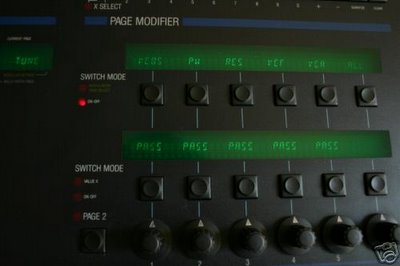

2 Voice Oberheim FVS
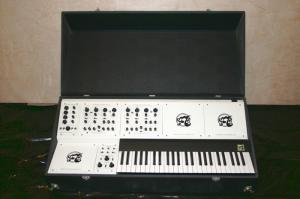
Title link takes you to shots pulled from this Craigslist post. The price at $1200 seems too good, but you never know. If found a pristine Yamaha CS60 on Craiglist for $375. For deals like this, I'd do local pickup only with checking it out first.
PREVIOUS PAGE
NEXT PAGE
HOME













© Matrixsynth - All posts are presented here for informative, historical and educative purposes as applicable within fair use.
MATRIXSYNTH is supported by affiliate links that use cookies to track clickthroughs and sales. See the privacy policy for details.
MATRIXSYNTH - EVERYTHING SYNTH













© Matrixsynth - All posts are presented here for informative, historical and educative purposes as applicable within fair use.
MATRIXSYNTH is supported by affiliate links that use cookies to track clickthroughs and sales. See the privacy policy for details.
MATRIXSYNTH - EVERYTHING SYNTH


